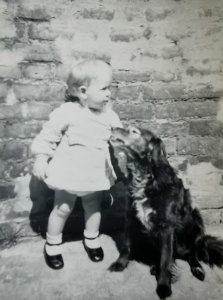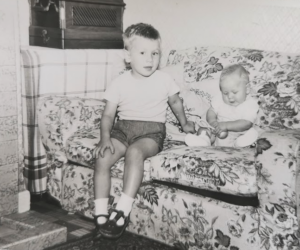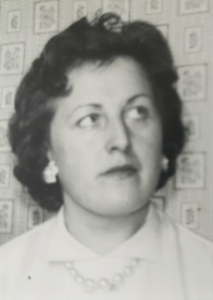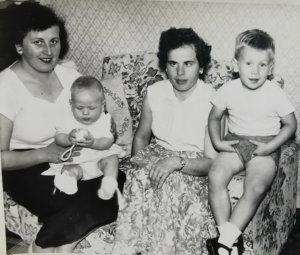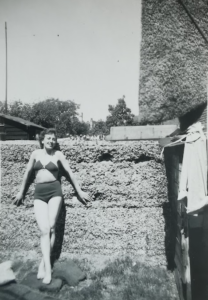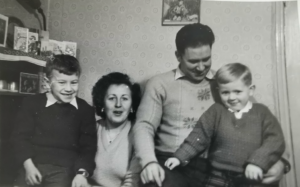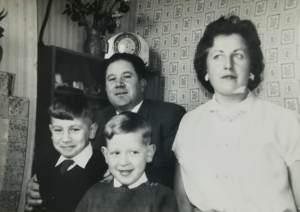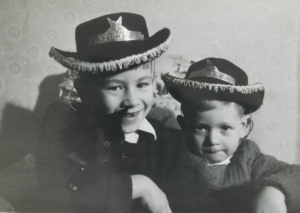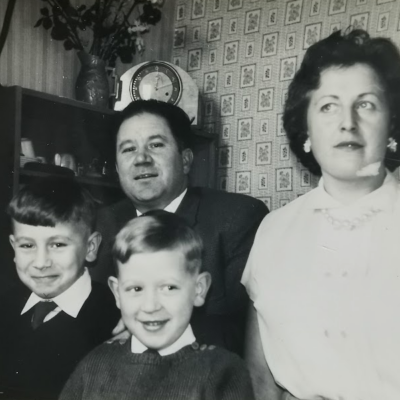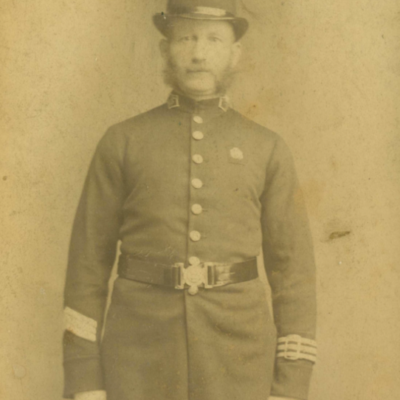Search by topic
- archaeology
- Building of Local Interest
- charity
- church
- crime
- dressmaker
- fire
- Great Eastern Railway
- Listed building
- Mapping Relief
- medieval
- oral history
- poverty
- Public House
- Rattee & Kett
- Religious House
- Roman
- scholar
- school
- Then and Now
- tudor
- women
- work
- world war one
- world war two
Search by text
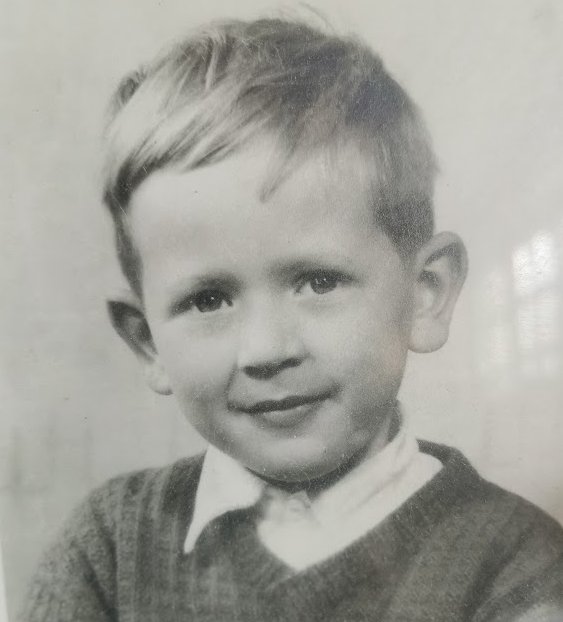 Frank Brzosko circ 1962
Frank Brzosko circ 196246 South Street
History of 46 South Street
Approximate position
In 2023 Frank Brzosko sent us his reminiscences of living in South Street; he was then interviewed in 2024. In 1962 Theodro Stefan Brzosko is listed at living at 46 South Street.
I will describe my memories; its ok for you too decide what’s appropriate and what isn’t; it’s quite a journey for me re. living old things. We lived at 45 South Street; I think it was 45 or 47, or was it 43 [actually 46]; it was at the far end on the Petersfield side. Mrs Flowers [Fuller] lived next door with her elderly dog; i can see her in my mind’s eye, a gentle lady, and another Miss Flowers [Fuller] on the otherside, more curt, and impatient.
There was a farmyard further up on the otherside, with chickens, pigs and a cow or cows, and the Nelson pub that I’m only vaguely aware of – my parents were not pub goers. My parents were immigrants, my father from Belarus, and my mother from northern Italy, brought together by the war.
The house we lived in was vary basic, two up and two down and tiny, with an outside toilet at the entrance at the back; it was a ten second journey to get there in all weathers, and it smelt bad. At night we had chamber pots, emptied daily. My parents owned it, and I’m grateful for that as I carried that independent streak. The photo on the website reminded me of the path at the back, and that wiggly bit, I never thought I’d see that again; little things like that counted at my age.
My father was a butcher who worked on East Road; he eventually moved to Wallers on Mitchams corner. I’m sure there must be some who remember him. He wanted his own shop, but never got there. We hardly had any money; it was a source of contention. I can’t remember my mother working when we lived in South Street; the way of doing things was traditional, the mother stayed home.
We went to the Catholic church on Sundays, high mass at 11-00; the church was packed out. We got dressed up, and had a hearty fried breakfast before hand. I’m grateful for that as I’ve carried that with me all my life. A note of interest is that my mother told me that she only agreed to marry my father if he went to church on Sundays, which he did, for a while; that was bound to end.
On the way back from church we would go to Sylvesters on East Road and have a glass of lemonade; we were very thirsty, masses lasted well over an hour; it was a treat we looked forward to, me and my brother.
South Street was for the poor. I remember a family that was better off moving in across the street – they had two kids. I remember the children looking out the window of their house at us; we wanted to play, the parents would not let them out. I felt sorry for them; it did not register that we were not good enough.
We did have a gang, if you could call it that; we played on Petersfield, and we did have problems with a boy who lived on Sturton Street, Charlie. I know his surname but we will skip that. He did bully us, and were frightened of him – we had stone fights. I remember one, we were on the alley leading up to Petersfield from Sturton Street, there was me, my brother Kevin and another I can’t remember who.
He was further up around the corner, and I remember thinking we were done if he charged us; he was a lot older, bigger, and threw big stones – that mattered. He lived with an aunt, and wasn’t well cared for – grubby, dirty. I met him as an adult, on East Road, and he was a grand fellow; I felt for him. I learnt to ride a bike on Petersfield; my first solo was arms and legs out like a star, crashing into a tree.
The tree is still there. We had time trials on bikes, racing round the edge of Petersfield, and played cricket against a tree , the bit closest too the roundabout and the telephone box. My brother was three years older and stronger; he regularly hit sixes, with a real cricket ball, hitting passing buses. I remember the old public toilets there. I was walking past them with my mother once, and a down-and-out tried to grab my leg; he and others were sat on benches there.
There was a lady who used to run across Petersfield with a shopping bag over her head, she was obviously ill, it happened often enough for me to remember.
We were bored one afternoon, and one of us, not me, started throwing stones at a drain pipe attached to a house on Sturton Street, the one on the left on the corner of the lane leading up to Petersfield.
There was a brick on the floor and I picked it up and threw it at the drain pipe, missing, and it went through a window; my intention was to hit the drain pipe. It made a tremendous crash, and we scarpered like bats out of hell. I ran back home shaking, filled the sink with water and sailed my boats as a form of comfort. I was shaking like a leaf in a hurricane. I was quite young at the time.
The owners put up a sign telling the perpetrator to own up. If they did not, they would not believe it was unintentional. I want to take this opportunity to say im sorry, …sorry. On Petersfield housewives gathered on weekends at lunchtime, to chat and socialise, on the big green bench; the post office was there at the time.
The swings, roundabouts and climbing frames were a source of permanent delight; on the swings it was about how high you could get, and jumping off at the swings highest point. I did that a few times and it hurt. There was a rumour that someone went over the top, that was probably untrue.
I loved the climbing frame, sliding down the poles at the corners. I’m running out of time, there might be more if my memory throws it up. I hope this is what you’re after. I have memories of Gwydir street, post 1963 or 4 whenever we moved.
Frank added the following information when interviewed in 2024.
Frank lived his early life at 46 [46 South Street T S Brzosko in Kelly’s 1962] South Street Cambridge. His father Theodor Brzosko, known as Stefan, had been born in Belarus. When that country had been overrun in WWII he joined the German army and was subsequently sent to Norway and then France where at some point he was captured by the Maquis and returned to the UK as a prisoner of war, first in Scotland, later further south. He would later joke with his wife that he had been a cook in the army, even though it seemed unlikely that there had been field kitchens where he served. At the end of WWII, Stefan was give the chance to remain and settle in the UK.
His mother was Alma, née Trugsnach, who was originally from northern Italy. Alma and Stefan met in Cambridge at the Dorothy Cafe. Later, Reena, Alma’s sister, came over from Italy to live in Cambridge as well. Stefan and Alma had two children, Frank and Tony. Frank’s father was a butcher who worked first in the shop in East Road [?no.190 East Road, Claude Wetherall] and then at A Waller and sons, 14 Victoria Av.
Frank first went to school at St Matthews. He remembered the children being given cots to rest in there while the teacher played the piano. Then he went to the Catholic school, St Albans, until the age of 11, where the headteacher was Mr Bates. He remembers the teacher Mr Lewis praying between lessons. Then to St Bedes; the head teacher was Mr Kent and his memories of the school were that it was not a very pleasant place.
People the family knew in Cambridge included Mr Kania [in 1962: S Kania, watchmaker, 23 Holland Street], the watchmaker in Victoria Road, who had been in a prisoner in a German concentration camp. Frank became aware at that time how large was the community of eastern European and Italian immigrants in Cambridge at the time. Their neighbour in South Street was Mrs Flowers [?Mrs J Fuller at 44 South Street in 1962].
The family then moved to 53 Gwydir Street.
Contribute
Do you have any information about the people or places in this article? If so, then please let us know using the Contact page or by emailing capturingcambridge@
License
This work is licensed under CC BY-NC-SA 4.0





